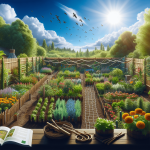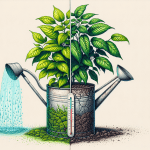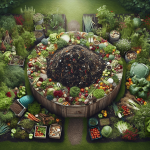This post may contain affiliate links. As an Amazon Associate, we may earn commissions from qualifying purchases.
How can you create a garden that supports soil regeneration? It’s a question that probably has you picturing endless rows of vegetables, worms contentedly wiggling through rich, dark soil, and neighbors nodding approvingly over your fence. Well, dream no longer! Soil regeneration isn’t just a pipe dream; it’s absolutely attainable. Even for someone with nothing but a tiny patch of green and the willpower to turn things around.
What is Soil Regeneration?
Before you get your hands dirty, let’s understand what soil regeneration means. Soil regeneration is the process of improving soil health by restoring its organic matter, microbial life, and overall structure. Think of it as a soil spa day. You’re giving your garden’s foundation the nourishment it needs to thrive.
Why Does It Matter?
Soil isn’t just the dirt under our feet – it’s a living, breathing entity that plays a crucial role in our ecosystem. Healthy soil supports plant growth, retains water efficiently, and combats climate change by sequestering carbon. Neglecting it or overusing chemical fertilizers can turn this powerhouse into just plain old dirt.
Conduct A Soil Test
The first step in this earthy spa treatment is to understand what you’re starting with. Conducting a soil test will give you the nitty-gritty details about your soil’s pH levels, nutrient content, and overall health.
How to Collect a Sample
Use a clean trowel to dig 6 inches into your soil. Take samples from multiple areas of your garden and mix them together in a clean container. Let it dry completely before sending it to a lab or using an at-home testing kit.
Understanding Results
Your soil test results will guide your next steps. It will reveal nutrient deficiencies, pH imbalances, and other problems. If your soil is too acidic or too alkaline, you can adjust it with the right amendments.
| Soil pH Level | Category | Recommended Action |
|---|---|---|
| Below 5.5 | Very Acidic | Add lime to raise pH |
| 5.5-6.5 | Slightly Acidic | Ideal for most plants |
| 6.5-7.5 | Neutral | Best for a wider variety of plants |
| Above 7.5 | Alkaline | Add sulfur or organic matter to lower pH |
Utilizing Organic Soil Amendments
Once you know your soil’s needs, it’s time to introduce organic amendments like compost, manure, or bone meal. These not only balance the nutrient levels but also foster microbial life.
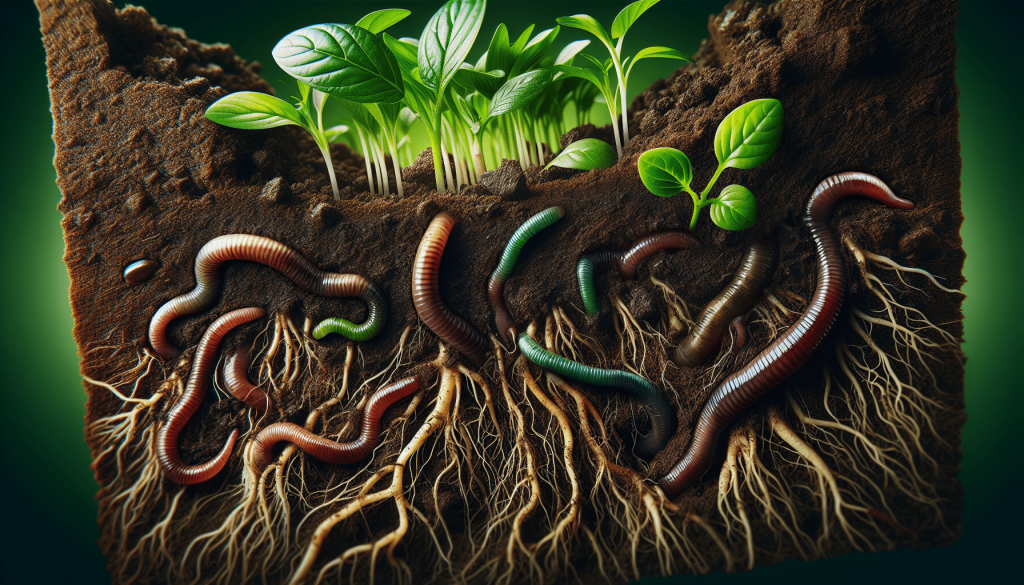
Composting: Your New Best Friend
No, composting isn’t just for the über-environmental folks with solar panels and electric cars. Anyone can compost, and boy, does it make a difference.
How to Start a Compost Pile
To get started, you’ll need a mix of ‘green’ materials (like vegetable scraps and coffee grounds) and ‘brown’ materials (like dried leaves and cardboard). Here’s a quick breakdown:
| Green Materials | Brown Materials |
|---|---|
| Fruit and vegetable scraps | Leaves |
| Coffee grounds | Cardboard |
| Grass clippings | Newspaper |
| Eggshells | Wood chips |
Maintaining Your Compost
Make sure your compost pile stays moist and gets a regular turn to keep everything breaking down efficiently. It’s like stirring a giant, earthy soup pot.
Practicing Crop Rotation
Rotating crops might sound like it’s reserved for massive farms, but the concept applies to gardens of any size. Different plants take different nutrients from the soil, so changing what you plant helps keep things in balance.
The Basics of Crop Rotation
Divide your garden into sections and categorize them by plant family. Rotate these sections each planting season. Here’s a simple example:
| Year | Section 1 (Legumes) | Section 2 (Leafy Greens) | Section 3 (Root Vegetables) | Section 4 (Fruiting Plants) |
|---|---|---|---|---|
| Year 1 | Peas, Beans | Lettuce, Spinach | Carrots, Beets | Tomatoes, Cucumbers |
| Year 2 | Lettuce, Spinach | Carrots, Beets | Tomatoes, Cucumbers | Peas, Beans |
| Year 3 | Carrots, Beets | Tomatoes, Cucumbers | Peas, Beans | Lettuce, Spinach |
| Year 4 | Tomatoes, Cucumbers | Peas, Beans | Lettuce, Spinach | Carrots, Beets |
Benefits of Crop Rotation
Crop rotation prevents the depletion of specific nutrients, reduces soil erosion, and minimizes the chance of pests and diseases taking hold. It’s like not wearing the same socks two days in a row – it just makes sense.
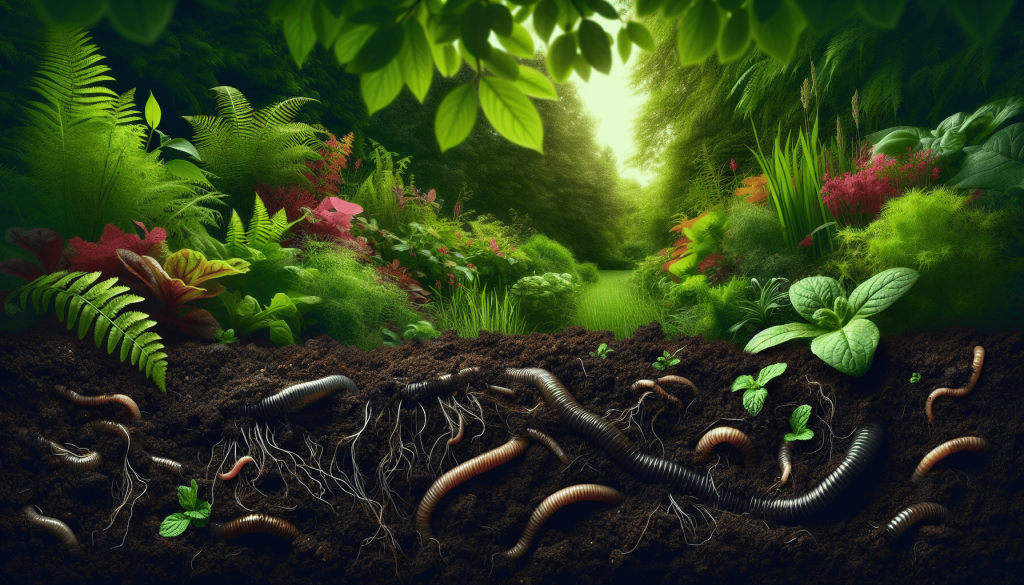
Cover Cropping: Blanket for Your Soil
Ever seen a field covered in greenery even when it’s not growing season? That’s cover cropping. These are plants grown to cover the soil during the off-season, not to harvest.
Types of Cover Crops
Depending on what your soil needs, you can choose from several types of cover crops:
| Goal | Ideal Cover Crop |
|---|---|
| Nitrogen Fixation | Legumes (e.g., clover, vetch) |
| Weed Suppression | Grasses (e.g., ryegrass) |
| Erosion Control | Deep-rooted plants (e.g., radishes) |
Planting and Maintaining Cover Crops
After your main crops are harvested, sow your cover crop seeds. Let them grow to maturity, then cut them back and till them into the soil. This green manure adds organic matter and nutrients back into the ground.
Mulching: The Protective Layer
Mulch isn’t just for making your garden look tidy; it’s a fantastic tool for soil regeneration.
Types of Mulch
There are two types of mulch: organic (e.g., hay, straw, wood chips) and inorganic (e.g., stones, plastic sheets). Organic mulch is preferable for soil health as it breaks down and adds nutrients to the soil.
| Type of Mulch | Benefits |
|---|---|
| Straw | Retains moisture, prevents weeds |
| Wood Chips | Adds nutrients as it decomposes |
| Grass Clippings | High nitrogen content |
Applying Mulch
Spread a 2-3 inch layer of mulch around your plants but keep it away from stems to prevent rot. Replenish it periodically as it breaks down.
Encouraging Beneficial Insects and Microbes
Believe it or not, your garden’s best friends are the ones you can’t see (and the ones you often try to shoo away).
Beneficial Insects
Ladybugs, lacewings, and bees are the MVPs here. They pollinate plants and keep harmful insects in check. Planting a variety of flowering plants can attract them to your garden.
Soil Microbes
Microbes like bacteria, fungi, and protozoa break down organic matter and recycle nutrients. To boost microbial activity, keep your soil moist and well-fed with organic matter.
Avoiding Chemical Fertilizers and Pesticides
Chemical fertilizers and pesticides might give you a quick boost, but they can wreak havoc in the long run.
Why They’re Harmful
They kill beneficial microbes, disrupt soil structure, and can lead to a chemical buildup that harms plant health. Think of them as junk food for your soil.
Natural Alternatives
Organic fertilizers like compost and manure are safer and more sustainable. For pest control, you can use neem oil, insecticidal soap, or even introduce predator insects.
Building a No-Till Garden
Traditional tilling disrupts soil structure and harms beneficial organisms. No-till gardening allows you to plant without disturbing the soil.
How to Start a No-Till Garden
Once your plants are harvested, don’t till the soil. Instead, add layers of compost and mulch directly on top.
Benefits of No-Till
This method improves soil structure, retains moisture, and encourages earthworm activity. It’s like cuddling up in bed without making a mess of the sheets.
Watering Wisely
Overwatering or underwatering can stress plants and degrade soil.
Best Practices
Water in the early morning to reduce evaporation. Use drip irrigation or soaker hoses to deliver water directly to the roots.
The Role of Mulch
Mulch helps retain soil moisture, so you don’t have to water as often. It’s like giving your garden a cozy blanket to snuggle under.
The Importance of Biodiversity
A diverse garden is a resilient garden. Biodiversity helps control pests, improves pollination, and reduces disease.
Planting a Variety
Mix annuals and perennials, vegetables, herbs, and flowers. The more diverse your garden, the healthier the ecosystem.
Companion Planting
Certain plants benefit each other when grown together. For instance, basil repels pests from tomatoes, while beans add nitrogen to the soil for corn.
Conclusion
Creating a garden that supports soil regeneration is an achievable goal, no matter the size of your plot. By understanding and nurturing your soil, you’re investing in the long-term health of your garden. And as an added bonus, you’ll be stepping up as an environmental steward.
So strap on those gardening gloves! Your thriving, regenerative garden is just a few thoughtful steps away from becoming a reality. Who knows? You might even have neighbors asking for tips before long.





